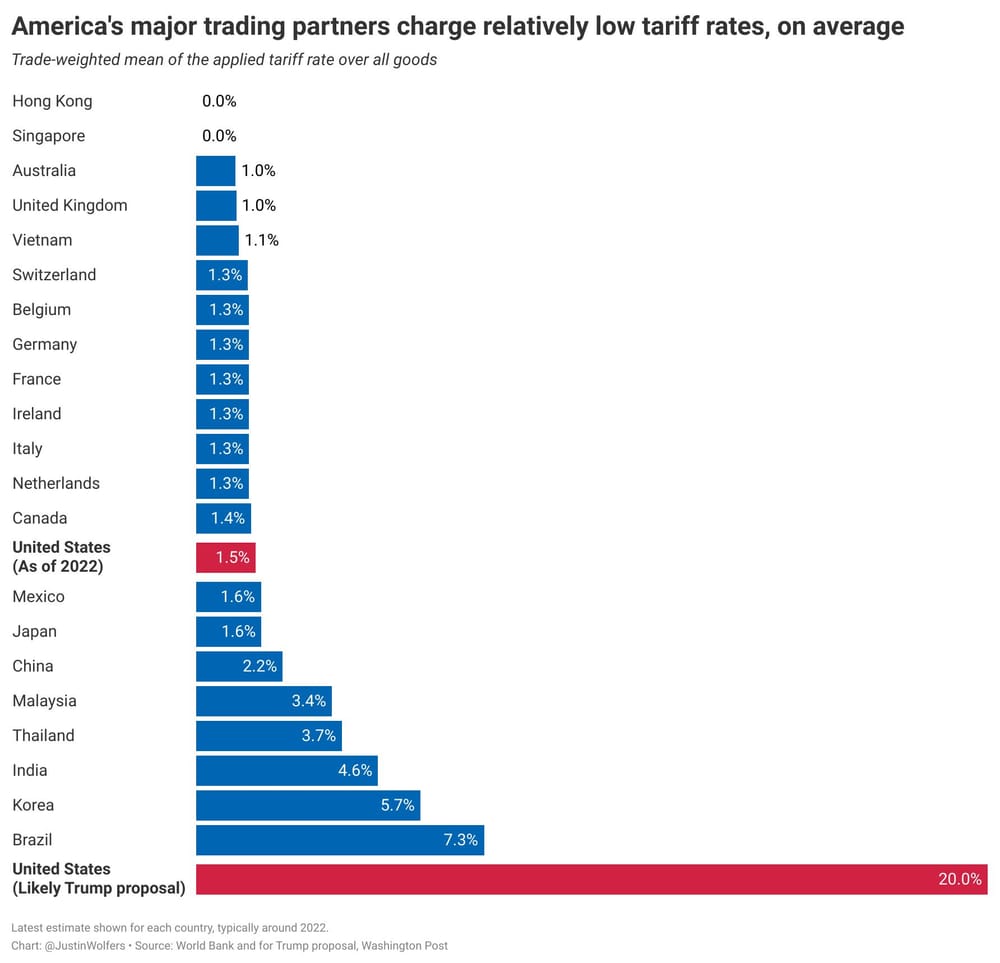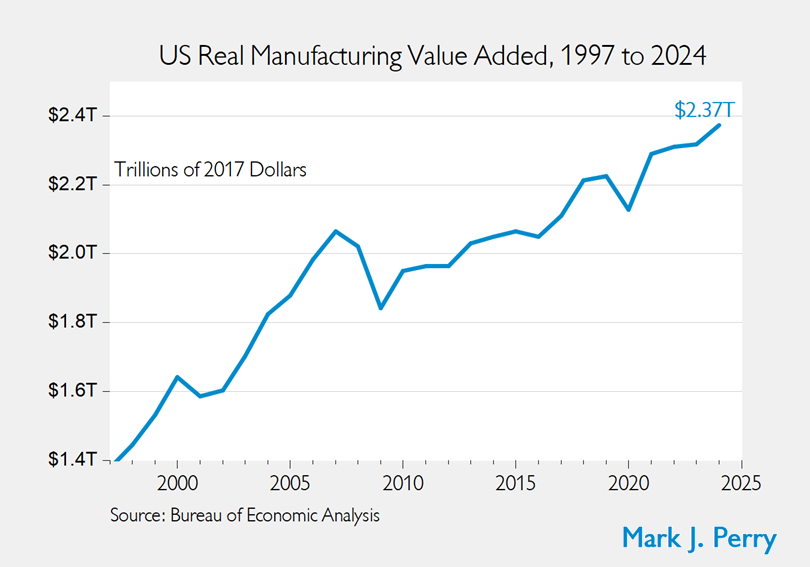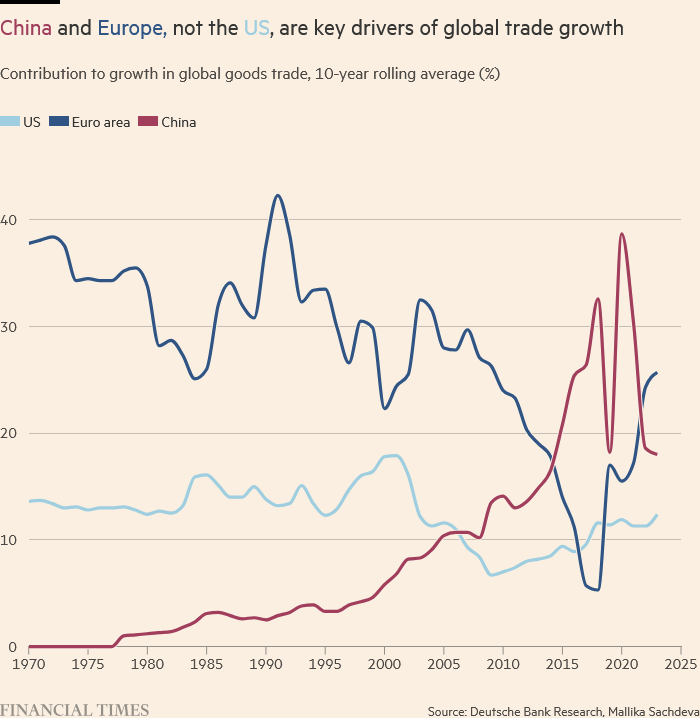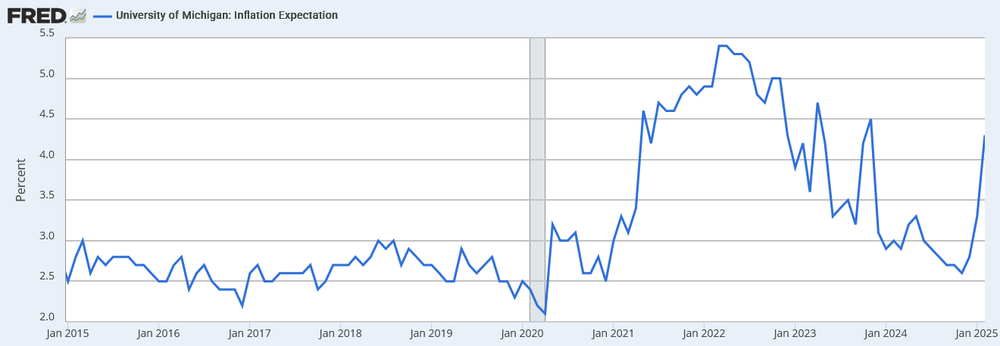Trump's Liberation Day
“It is the theory of the Protectionist that imports are an evil. He thinks that if you shut out the foreign-imported manufactured goods you will make these goods yourselves, in addition to the goods which you make now, including those goods which we make to exchange for the foreign goods that come in. If a man can believe that he can believe anything. [Laughter.] We Free-traders say it is not true. To think you can make a man richer by putting on a tax is like a man thinking that he can stand in a bucket and lift himself up by the handle.” — Winston Churchill, 1904.
Well, it’s finally here—after weeks of economically destructive uncertainty, US President Trump finally revealed an economically destructive plan for his so-called “Liberation Day”.

Here’s the summary so far:
- A minimum, universal 10% tariff on all imports, which is lower than the 20% that had been rumoured (Australia falls into this 10% bucket). Canada and Mexico are exempt because of the original 25% duties slapped on last month.
- Tariff rates have been calculated using “currency manipulation and trade barriers”, i.e. a completely arbitrary metric that appears to include value-added taxes (VAT). According to Trump, “we will charge them approximately half of what they are and have been charging us”.
- UPDATE: It’s worse than that. The tariffs have been calculated using the formula of MAX(10%,(imports-exports)/imports) per-country on a customs basis. Absolute nonsense.
- These new tariffs are bigger than the Great Depression-era Smoot-Hawley tariffs, which “contributed to a decline in world trade and provoked discrimination against US exports that lasted decades”.
- The tariffs go hardest on countries that have historically run large trade deficits with the US, which are not necessarily those with the highest trade barriers, including the likes of China (34%), Japan (24%), and Korea (25%).
- This could be economically devastating for some of Australia’s regional neighbours like Vietnam (46%), which is where many companies relocated their production away from China.
- For good measure, there’s also a flat 25% tariff on “all foreign-made automobiles”.
- SPY futures plunged more than 2% as soon as the tariff rates were announced.
The evidence cited by the White House to support these tariffs is incredibly flimsy, containing various studies that ignore all the costs (e.g. economy-wide effects), conflate relative price changes with inflation, or are outright falsehoods spouted by groups like “The Coalition For a Prosperous America”.
Meanwhile, the large body of recent empirical work showing that the Trump 1.0 and Biden tariffs raised costs for consumers, lowered incomes, and reduced manufacturing employment, were conveniently omitted.
As for the inclusion of VATs—the only way to get Australia to 10% is to count the GST—as being equivalent to a trade barrier (they’re not even close), there are two reasons for that. First, legal constraints limit Trump’s options for unilateral tariffs to ‘reciprocity’. Second, Trump needed an excuse to get rates up because most countries don’t actually tariff US goods all that much:

Basically, the numbers are all made up and it’s an elaborate exercise in reverse engineering to get to Trump’s real objective: universal tariffs. As for what comes next and what it means for Australia there are a few possibilities, most of which hinge on just how much pain Trump—and his fellow Republicans—can tolerate once voters start to feel him ‘Liberating’ the cash out of their wallets.
The ‘most beautiful word in the dictionary’
Trump loves tariffs. While some in his administration, notably Treasury Secretary Scott Bessent, still push the idea that this is some grand ‘art of the deal’ negotiating move to usher in global free trade, Trump himself is deeply protectionist.
It’s why he so derides the ’ globalists’ who oppose his plan, no matter how much they cite centuries of economic theory and decades empirical evidence across hundreds of countries showing that tariffs cause “adverse effects on output growth”.
You must remember that Trump was relatively constrained during his first term. It was his first taste of government, and he appointed mostly rank-and-file establishment types to key positions (including VP) that pushed back against his most ludicrous ideas.
This time around not only is he experienced in the role, but he had an extra four years to assemble a team of MAGA crackpots. There are no longer voices of reason within the President’s orbit to offset the likes of Peter Navarro, an economically illiterate close Trump advisor who holds views that are the trade equivalent of modern monetary theory.
But let me be clear: there is no economic upside to this plan, just varying degrees of turmoil and uncertainty, contingent on how Trump uses these new tariffs to make domestic and international political plays.
Tariffs are a tax on importers, so Trump will now be able to arbitrarily choose to whom he will provide subsidies to offset the resulting costs, or just as powerfully, not subsidise—all depending on how adeptly they bend the knee in the face of his power.
The same is true in the international arena. While these tariffs will cost the US as a whole much more than its trading partners, on a per person basis the damage to those partners will be greater because there are fewer of them. For example, the tariffs per Canadian are more than double the cost per American. If you add in the Canadian government’s retaliation, those per person costs become even greater.
That gives Trump leverage to negotiate whatever else he has in store for the world—" whether it is getting allies to spend more on their own defence, opening foreign markets to US exports, securing cooperation on ending illegal immigration and interdicting fentanyl trafficking, or deterring military aggression"—or perhaps even a global depression-risking currency accord.
But such ’leverage’ comes at great cost. Every ‘buy America’ subsidy creates a deadweight loss and causes labour and capital to be misallocated to areas where they’re less productive. Local goods will only become relatively because cheaper foreign goods are priced out by tariffs—meaning prices for American goods will also be higher than a world without tariffs. Any retaliation will only compound these effects.
To the extent that tariffs “supercharge our domestic industrial base” – as Trump claimed in his speech – they will do so only by making it poorer, with any benefits captured by inefficient producers who gain at the expense of consumers. And it’s not like the US ever de industrialised in the first place, regardless of how many times those in the Trump administration repeat that particular falsehood:

As for the jobs that have been lost, most of them have gone to robots (raising manufacturing productivity), not foreigners, with the people that would have otherwise been employed in manufacturing finding work elsewhere (the US unemployment rate is around 4.1%).
An optimistic end-game
There are two main forces at play now: how long Trump can withstand the domestic political pressure that all this ‘winning’ is going to cause his party; and how other countries respond to it.
Starting with the latter, the European Union has vowed to retaliate but is also “open to negotiations”. Canada, China, and Mexico already retaliated to the first round of tariffs on steel and aluminium. While further retaliation will only hurt their own people even more, many countries might still feel it’s in their political interest to do so.
But Trump’s tariffs are also causing trade to be freed up elsewhere. For example, Vietnam and Israel just scrapped a bunch of tariffs yesterday:
“Vietnam, in a race to head off possible new US tariffs, announced it slashed import levies on a range of products, including liquefied natural gas and automobiles, according to a statement on the government’s website.”
“The removal of tariffs on American goods is another step … to open the market to competition, to diversify the economy, and to lower the cost of living,” Prime Minister Benjamin Netanyahu said in a joint statement with Barkat and Finance Minister Bezalel Smotrich.
Trump has also managed to mend bridges between China, Japan, and South Korea—three countries with a long history of ‘disagreements’, to put it lightly. All three will now work to “speed up talks on a South Korea-Japan-China free trade agreement deal to promote ‘regional and global trade’”.
That’s all good news: the rest of the world – and a strong majority of Americans – still believe in free trade, political cycles are short, and so while Trump is going to cause great damage to the US and global economies, it might only be temporary. Moreover, while nevertheless important, the US isn’t a large driver of global trade:

For its part, Australia has yet to announce anything concrete. Making concessions to Trump would be a bad idea, but if you had to toss something out, the rationale for the news bargaining code was dodgy from the get-go and it should be scrapped on those grounds alone.
Other than that, the way to win at foreign trade is not to engage in tit-for-tat arguments over what is or isn’t ‘fair’, but to forge new ties and tackle domestic policy issues, including rules and regulations that stifle development, perpetual structural budget deficits that crowd out the private sector, and growing levels of public debt that increase Australia’s vulnerability to shocks.
Economic resilience comes from diversity, not self-sufficiency.
The way to lose at foreign trade is to follow Trump down the slippery slope of tariffs and retaliation, followed by discretionary intervention to offset some of the side-effects (rent seekers rejoice), ever-growing deficits to pay for it all, culminating in a poorer country that’s more vulnerable to shocks, not less.
Which takes me back to the first force: how long can Trump sustain these tariffs, even if the rest of the world does nothing? Goldman Sachs estimated that a 15% across-the-board tariff would see GDP will fall by about 0.5 percentage points, while prices will increase by the same amount, largely because trade is only a small part of the US economy. I’m not sure what the weighted average tariff rate of the new hodgepodge of rates will be, but it might be something close to that.
Costly to be sure, but not as significant as many other policy distortions in the US economy. However, policy should never be considered in isolation, and there are other shocks at work. First, the effects of the large positive US labour supply boost from the big up-tick in migration during the Biden years have faded. Second, inflation has already started to increase again, and consumer inflationary expectations—a reasonably good predictor of actual inflation—have shot right back up:
Trump’s tariffs and any retaliation may also cause US real interest rates to rise, slowing investment and consumption growth. And while you should never bet against the US, the only major offsetting factors at this stage are the gargantuan budget deficits and potential for the 2017 tax cuts to be extended later this year ( DOGE is a big nothing burger). But if you don’t have a credible way to pay for all of that spending—and tariffs aren’t a serious answer—then the US may end up mired in stagflation.
So while there’s no clear S&P 500 ‘Trump put’ this time around, perhaps one might come from his own party. At the FT’s Tej Parikh recently speculated:
“As the effects of import duties come through to households, confidence and approval could dip further. With Americans still reeling from a 20 per cent post-pandemic jump in the price level, their threshold for further pain is limited. This could raise pressure from the White House or the GOP to dial things down. The 2026 midterms will quickly come into view.”
Trump loves tariffs for their own sake, but even he may eventually buckle under the pressure of his own supporters turning against him.
Comments
Comments have been disabled and we're not sure if we'll ever turn them back on. If you have something you would like to contribute, please send Justin an email or hit up social media!


